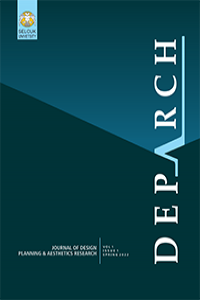READING MIXED BUILDINGS FROM THE PERSPECTIVE OF PUBLIC SPACE: THE CASE OF ZORLU CENTER
READING MIXED BUILDINGS FROM THE PERSPECTIVE OF PUBLIC SPACE: THE CASE OF ZORLU CENTER
Living Center, Mixed Structure, Public Space Spatial Quality, Zorlu Center.,
___
- Akgün, T. D. (2010). Karma işlevli yapıların kentsel ve mimari tasarım arakesitinde kamu yararı gözetilerek irdelenmesi: Zincirlikuyu-Levent aksı örneği [Unpublished master's thesis]. İstanbul Teknik Üniversitesi, Fen Bilimleri Enstitüsü, İstanbul.
- Arolat, E. (2021a). Emre Arolat’ın Mimarlığı Üzerine Görüşme-1 [Speech text].
- Arolat, E. (2021b). Emre Arolat’ın Mimarlığı Üzerine Görüşme-2, [Speech text].
- Aslankan, A. (2014). Mixed-use high-rise (residential) complexes: a new urban form (ation) in İstanbul [Unpublished master’s dissertation]. Ortadoğu Teknik Üniversitesi, Fen Bilimleri Enstitüsü, Ankara.
- Ataoğlu, N. C. (2009). Çağdaş mimaride bir antitez: sirkülasyon [Unpublished doctoral thesis]. Karadeniz Teknik Üniversitesi, Fen Bilimleri Enstitüsü, Trabzon.
- Bali, R. N. (2002). Tarz-ı hayat’tan life style’a yeni seçkinler, yeni mekânlar, yeni yaşamlar. İstanbul: İletişim Yayınları.
- Benedikt, M. L. (1979). To take hold of space: isovist and ısovist fields. Environment and Planning B, 6, 47-65.
- Berk, İ. (1996). Pera. İstanbul: Adam Yayınları.
- Bilgin, M. (2006). Karma kullanımlı merkezlerin kent ve günlük yaşam içerisindeki yeri: İstanbul’dan örnekler [Unpublished master’s thesis]. Gazi Üniversitesi, Fen Bilimleri Enstitüsü, Ankara.
- Bora, T. (2009). Fatih'in İstanbul'u siyasi islamın altenatif küresel şehir hayalleri. İçinde Ç. Keyder (Ed.). İstanbul küresel ile yerel arasında. İstanbul: Metis Yayınları.
- Ching, F. D. K. (2002). Mimarlık biçim mekân ve düzen. İstanbul: YEM Yayınları.
- Çevik, S. (1991). Mekân-kimlik-kimliklendirme Trabzon sokakları örneği [Unpublished doctoral thesis]. Karadeniz Teknik Üniversitesi, Fen Bilimleri Enstitüsü, Trabzon.
- Demirkaya, H. (1999). Mekân kavramının tarihsel süreç içinde incelenmesi ve günümüzde mekân anlayışı [Unpublished doctoral thesis]. Yıldız Teknik Üniversitesi, Fen Bilimleri Enstitüsü, İstanbul.
- Demirtaş, S., Diken, B., & Gözaydın, İ. B. (1996). Mekân ve ötekiler. Defter Dergisi, 28, 39-44.
- Derman, B. (1989). Karma fonksiyonlu binalarda temel planlama sorunları [Unpublished master's thesis]. Yıldız Teknik Üniversitesi, Fen Bilimleri Enstitüsü, İstanbul.
- Dinçer, Ö. (2005). Mimari mekân organizasyon sürecinde mekânsal hemyüzey birleşim ve entegrasyon kavramlarının analizi [Unpublished doctoral thesis]. Dokuz Eylül Üniversitesi, Fen Bilimleri Enstitüsü, İzmir.
- Ersoy, Z., & Süer, D. (2002). İç’teki dış. Yapı Dergisi, 248, 62-68.
- Gür, Ş. Ö. (1996). Mekân organizasyonu. İstanbul: Birsen Yayınevi.
- Hocaoğlu, P. (2014). Türkiye’deki karma kullanımlı yapıların kentsel tasarım ilkeleri doğrultusunda incelenmesi [Unpublished master’s thesis]. Karadeniz Teknik Üniversitesi, Fen Bilimleri Enstitüsü, Trabzon.
- Hoppenbrouwer, E., & Louw, E. (2005). Mixed-use development: theory and practice in Amsterdam’s eastern docklands. European Planning Studies, 13(7), 967-983.
- İnceoğlu, M. (2004). Mimarlıkta söylem kuram ve uygulama. İstanbul: Tasarım Yayın Grubu.
- Kruse, L. (1974). Räumliche umwelt. Die phänomenologie des räumlichen verhaltens als beitrag zu einer psychologischen umwelttheorie. Berlin: Walter de Gruyter.
- Köhler, C. (1981). Stadterleben, kritische betrachtungen zu wahrnehmungs und verhaltenstheoretischen ansätzen und zur praxis der gegenwärtigen stadtgestaltung. Frankfurt: R. G. Fischer Verlag.
- Noraslı, M., & Köse Doğan, R. (2020). Çağdaş ofis tasarımları üzerine bir inceleme, bee rendering tasarım ofisi. Artium, 8(1), 1-10. Onat, E. (1991). Mimarlık, form ve geometri. Ankara: Efil Yayınevi Yayınları.
- Özdoğan, H. (2002). Türkiye’de meydanlar [Unpublished doctoral thesis]. Karadeniz Teknik Üniversitesi, Fen Bilimleri Enstitüsü, Trabzon.
- Özoral, K. (2015). Sermayenin yeni mekânları: Büyük ölçekli karma yapılar [Unpublished master’s thesis]. İstanbul Teknik Üniversitesi, Fen Bilimleri Enstitüsü, İstanbul.
- Rabianski, J. S., Gibler, K. M., Tidwell, O. A., & Clements, J. S. (2009). Mixed-use development: a call for research, Journal of Real Estate Literature, 17(2), 205-230.
- Rapoport, A. (1990). Meaning of the built environment. Tucson: The Universiy of Arizona Press.
- Rowley, A. (1996). Mixed-use development: ambiguous concept, simplistic analysis and wishful thinking?. Planning Practice and Research, 11(1), 85-97.
- Schwanke, D. (2003). Mixed-use development handbook. Washington: ULI Publishers.
- Soja, E. W. (2000). Postmetropolis: critical studies of cities and regions. Oxford: Blackwell Publishers.
- Şahin, F. (2005). Alışveriş merkezlerinin biçimlenmesinde önemli boyutlardan kamusal mekân ve kamusallık olgusu [Unpublished master’s thesis]. Karadeniz Teknik Üniversitesi, Fen Bilimleri Enstitüsü, Trabzon.
- Şahin, F., & Tutkun, M. (2007, April 30-May 5). Tourism development in shopping centers [Paper presentation]. International Tourism Biennial, Onsekiz Mart University, Canakkale, Turkey.
- Şahin, F. (2008, May 17-19). Teknolojinin alışveriş merkezlerindeki mekânsal oluşuma yansıması [Bildiri sunumu]. 3. Ulusal Genç Mimarlar Buluşması, Mimarlık ve Teknoloji Sempozyumu, Antalya, Türkiye.
- Şahin, F. (2011). Günümüz alışveriş merkezlerinde kentsel kamusal mekân olgusu [Unpublished doctoral thesis]. Karadeniz Teknik Üniversitesi, Fen Bilimleri Enstitüsü, Trabzon.
- Şahin, F., & Hocaoğlu, P. (2015, May 28-30). Mixed use building design and sustainable architecture [Paper presentation]. 2nd International Sustainable Buildings Symposium, Gazi Üniversitesi, Ankara, Turkey.
- Şahin, F., & Tavşan, C. (2018, November 30-December 2). Art and Social Life in Urban Public Spaces [Paper presentation]. 2nd International Symposium on Innovative Approaches in Scientific Studies, Samsun, Turkey.
- URL 1- https://emrearolat.com/project/zorlu-center-mixed-use-complex
- URL 2- https://www.tabanlioglu.com/project/zorlu-center/
- URL 3- Emre Arolat. (2018, September 3). Emre Arolat [Video]. https://www.youtube.com/watch?v=YGGhoVegaKg
- URL 4- Emre Arolat. (2013, October 10). Emre Arolat Zorlu Center [Video]. https://www.youtube.com/watch?v=5N2XG5k1RKw
- URL 5- Emre Arolat (2020, December 9). Türkiye'de çağdaş sanatın önemi [Video]. https://www.youtube.com/watch?v=a9TGj9KA-a0
- URL 6- Emre Arolat (2019, August 2). Dünya'daki en iyi mimarlardan!!!!/Emre Aralot söyleşi [Video]. https://www.youtube.com/watch?v=COcjCpYGCDQ
- Varol, A. İ. (2009). Yapı-kent ilişkisi bağlamında karma kullanımlı yapılar [Unpublished master’s thesis]. İstanbul Teknik Üniversitesi, Fen Bilimleri Enstitüsü, İstanbul.
- Yayın Aralığı: Yılda 2 Sayı
- Başlangıç: 2022
- Yayıncı: Selçuk Üniversitesi
READING MIXED BUILDINGS FROM THE PERSPECTIVE OF PUBLIC SPACE: THE CASE OF ZORLU CENTER
Affect, Architecture and Water: Bibliometric Analysis of the Literature
Urban Public Streets in the Collective Memory: A Case Study Of Uray Street In Mersin
Food Producing Facades Key to a Sustainable Future
PHYSICAL PLANNING APPROACHES OF TODAY'S CEMETERIES: KAYSERİ ASRİ CEMETERY CASE
